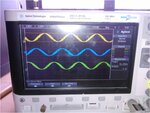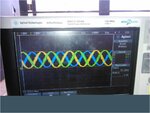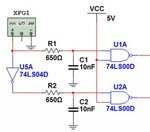mobinmk
Full Member level 2

- Joined
- May 27, 2010
- Messages
- 140
- Helped
- 4
- Reputation
- 8
- Reaction score
- 4
- Trophy points
- 1,298
- Location
- Kollam (Quilon),kerala, India
- Activity points
- 2,484
Hi frnds,
am doing project , variable frequency of 3 phase iinduction motor.
succesfully i generated 3 spwm frequency which is 120 deg phase each other.by arduino uno (atmega328 uc) using 3 phase DDS(sine look uptable,timer,interrupt)
SPWM freq is 33khz (carrier frequency).
in order to verify the output of spwm pulses.
output of spwm pulses is fed into 12.5khz low pass chebsyc filter.
filter ckt given below

output of filter in dso is


also the freq can vary from 0 -1023hz.
nw i wan to make dead time ckt and invert of 3pulses, so total 6 pulses to 3 phase inverter (6 igbt).
dead time required is 1 or 2us. it depend on the value of R and C of dead time ckt.
i try to design the circuit.

any modification is needed in this ckt ??
pls share your knowledges
regards
mobin
am doing project , variable frequency of 3 phase iinduction motor.
succesfully i generated 3 spwm frequency which is 120 deg phase each other.by arduino uno (atmega328 uc) using 3 phase DDS(sine look uptable,timer,interrupt)
SPWM freq is 33khz (carrier frequency).
in order to verify the output of spwm pulses.
output of spwm pulses is fed into 12.5khz low pass chebsyc filter.
filter ckt given below
output of filter in dso is


also the freq can vary from 0 -1023hz.
nw i wan to make dead time ckt and invert of 3pulses, so total 6 pulses to 3 phase inverter (6 igbt).
dead time required is 1 or 2us. it depend on the value of R and C of dead time ckt.
i try to design the circuit.

any modification is needed in this ckt ??
pls share your knowledges
regards
mobin



